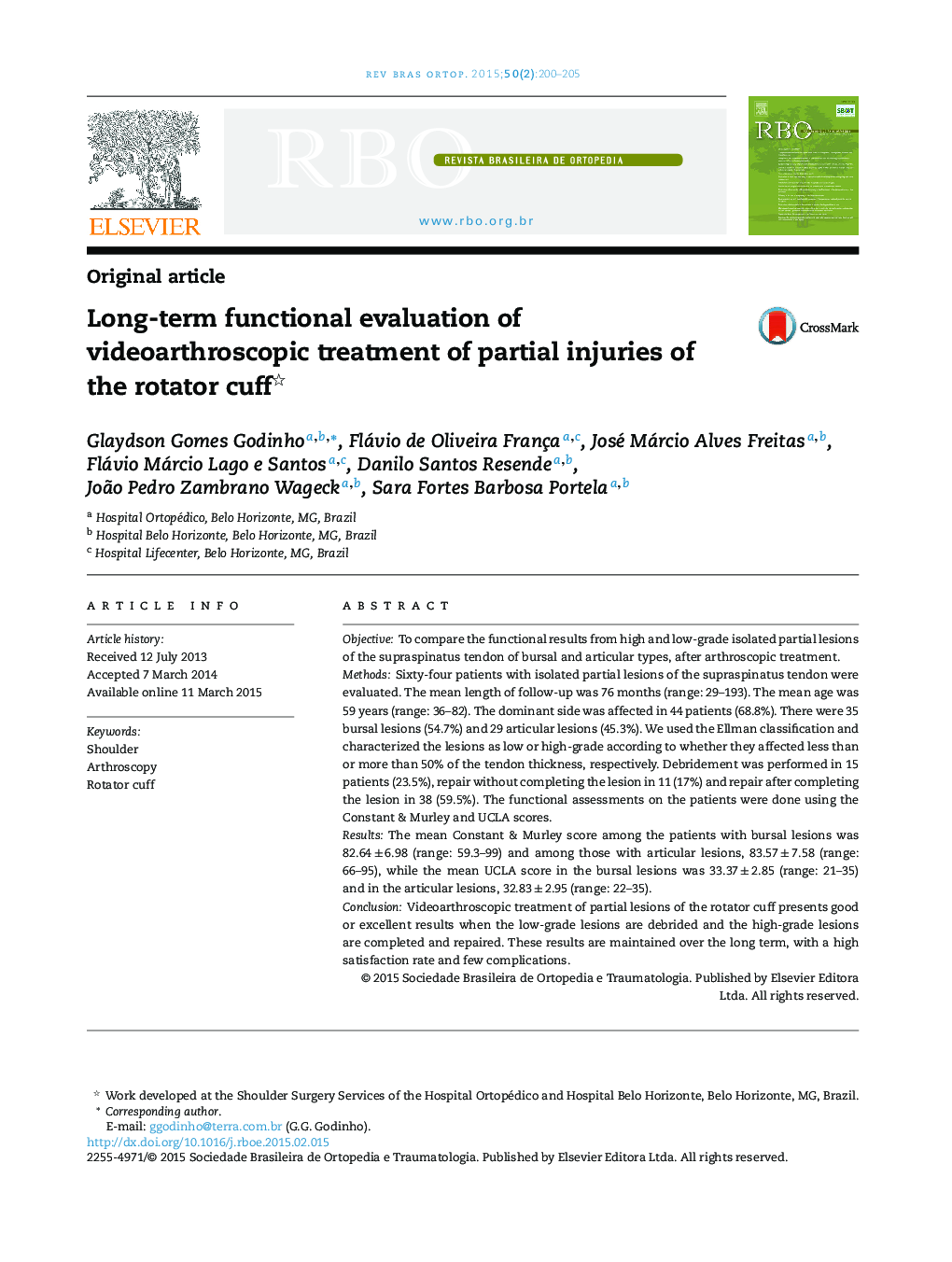| کد مقاله | کد نشریه | سال انتشار | مقاله انگلیسی | نسخه تمام متن |
|---|---|---|---|---|
| 2713590 | 1145164 | 2015 | 6 صفحه PDF | دانلود رایگان |

ObjectiveTo compare the functional results from high and low-grade isolated partial lesions of the supraspinatus tendon of bursal and articular types, after arthroscopic treatment.MethodsSixty-four patients with isolated partial lesions of the supraspinatus tendon were evaluated. The mean length of follow-up was 76 months (range: 29–193). The mean age was 59 years (range: 36–82). The dominant side was affected in 44 patients (68.8%). There were 35 bursal lesions (54.7%) and 29 articular lesions (45.3%). We used the Ellman classification and characterized the lesions as low or high-grade according to whether they affected less than or more than 50% of the tendon thickness, respectively. Debridement was performed in 15 patients (23.5%), repair without completing the lesion in 11 (17%) and repair after completing the lesion in 38 (59.5%). The functional assessments on the patients were done using the Constant & Murley and UCLA scores.ResultsThe mean Constant & Murley score among the patients with bursal lesions was 82.64 ± 6.98 (range: 59.3–99) and among those with articular lesions, 83.57 ± 7.58 (range: 66–95), while the mean UCLA score in the bursal lesions was 33.37 ± 2.85 (range: 21–35) and in the articular lesions, 32.83 ± 2.95 (range: 22–35).ConclusionVideoarthroscopic treatment of partial lesions of the rotator cuff presents good or excellent results when the low-grade lesions are debrided and the high-grade lesions are completed and repaired. These results are maintained over the long term, with a high satisfaction rate and few complications.
ResumoObjetivoComparar os resultados funcionais, após o tratamento artroscópico, das lesões parciais isoladas do tendão supra-espinal dos tipos bursal e articular nos graus alto e baixo.MétodosForam avaliados 64 pacientes com lesões parciais isoladas do tendão supra-espinal. Seguimento médio de 76 meses (29 a 193). A média de idade foi de 59 anos (36 a 82). O lado dominante foi acometido em 44 pacientes (68,8%). Observadas 35 lesões bursais (54,7%) e 29 articulares (45,3%). Usamos a classificação de Ellman e caracterizamos as lesões como baixo e alto grau quando acometiam menos ou mais de 50% de sua espessura, respectivamente. Foi feito desbridamento em 15 pacientes (23,5%), reparo sem completar a lesão em 11 (17%) e reparo após completar a lesão em 38 (59,5%). A avaliação clínica funcional dos pacientes foi feita com o uso dos escores de Constant & Murley e UCLA.ResultadosA média dos escores de Constant dos pacientes com lesão bursal foi de 82,64 ± 6,98 (59,3 a 99) e com lesão articular foi de 83,57 ± 7,58 (66 a 95), enquanto que a média do UCLA nas lesões bursais foi de 33,37 ± 2,85 (21 a 35) e nas lesões articulares foi de 32,83 ± 2,95 (22 a 35).ConclusãoO tratamento videoartroscópico das lesões parciais do manguito rotador apresenta resultados bons/excelentes quando as lesões de baixo grau são desbridadas e as lesões de alto grau são completadas e reparadas. Esses resultados se mantêm em longo prazo, com alto índice de satisfação e poucas complicações.
Journal: Revista Brasileira de Ortopedia (English Edition) - Volume 50, Issue 2, March–April 2015, Pages 200–205